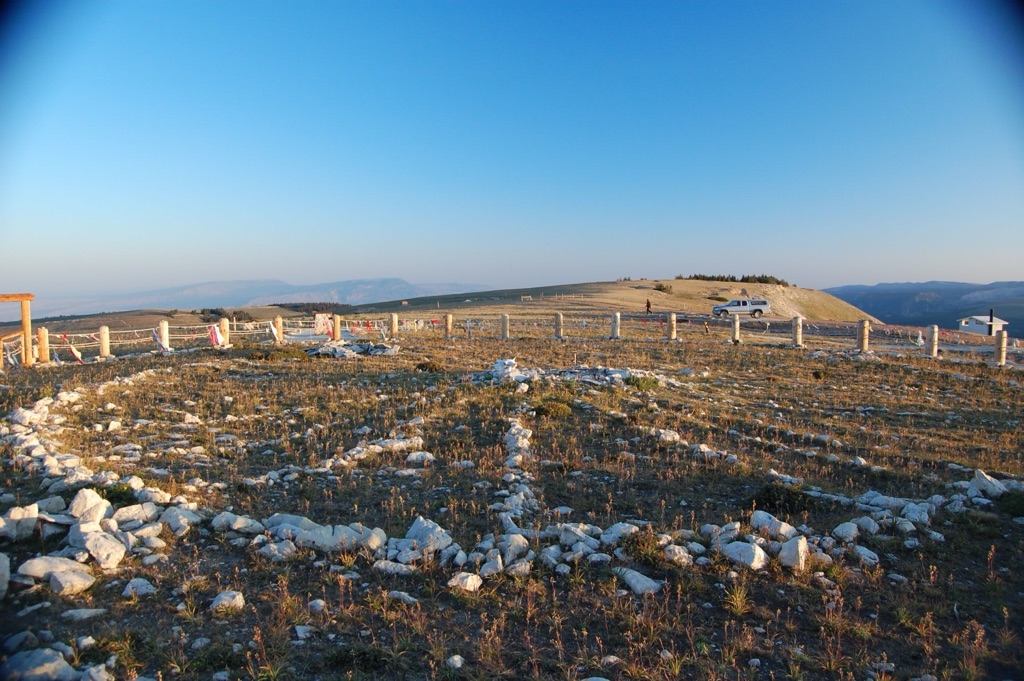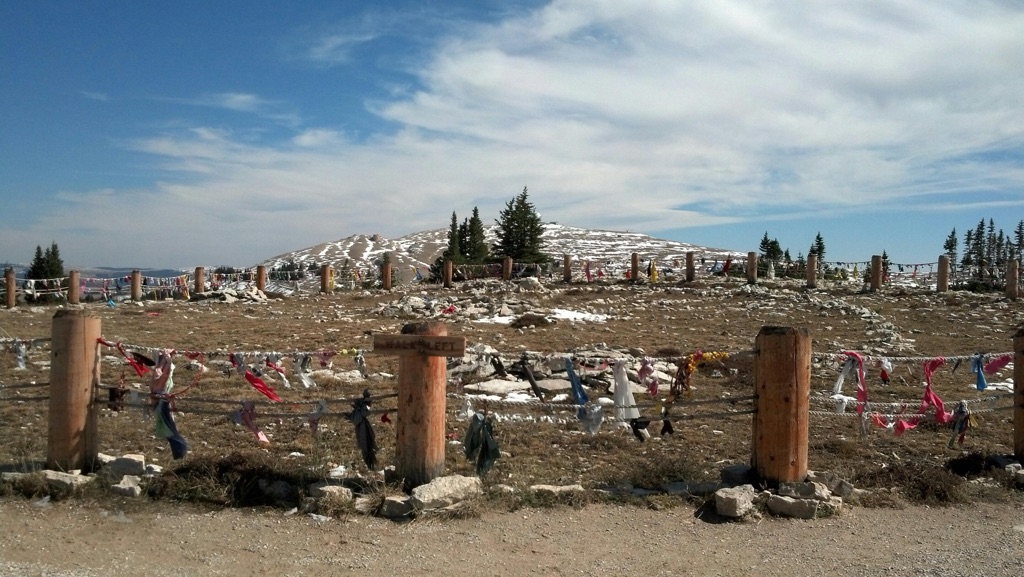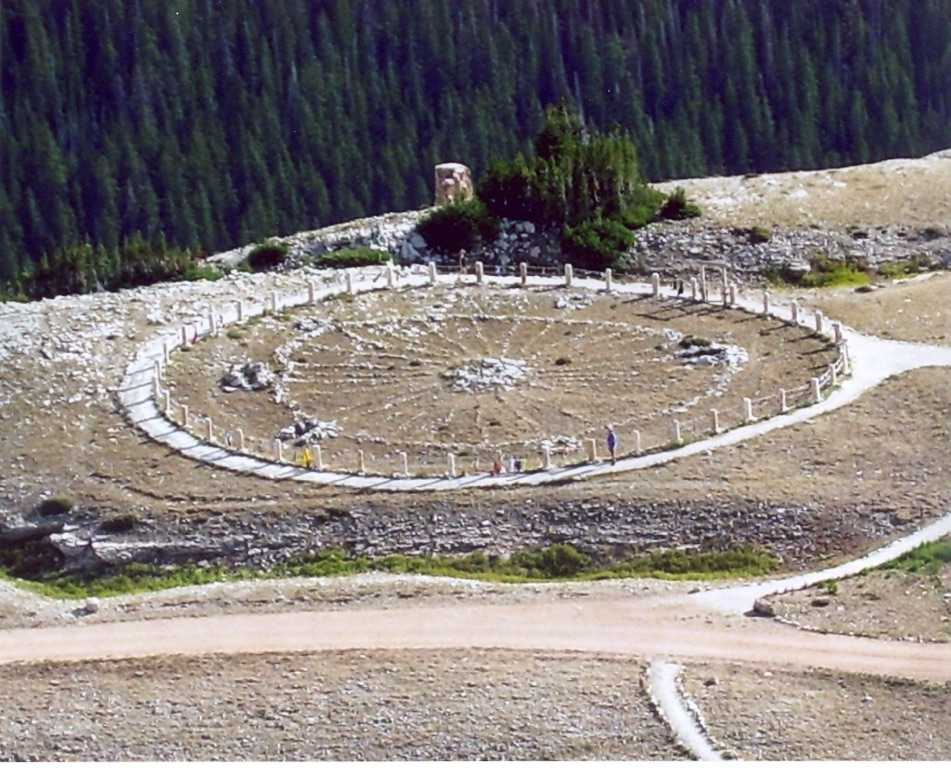Summary
Ancestral Legacy and Spiritual Significance
The Bighorn Medicine Wheel embodies a rich tapestry of Native American heritage, where ancient belief systems intersect with the vast expanse of the sky and earth. Positioned at the high elevation of the Bighorn Mountains, the wheel’s structure—a central cairn linked by radiating spokes to an outer rim—serves as a sacred symbol in Native American cosmology. The site not only offered a place for ritual and social gatherings for various tribes but also stands as a testament to their intricate knowledge of the environment, used for celestial observations and marking the change of seasons.
Get your dose of History via Email
Historical Discovery and Scholarship
The wheel’s significance grew when it was brought to the attention of the wider public, primarily by prospectors in the 19th century, followed by archaeologists who recognized its cultural and historical value. Studies unveiled its probable construction date around 700 years ago, necessitating ongoing preservation efforts and respect for its sacredness. Its alignment with astronomical events hints at the extraordinary wisdom of its creators and its role as a guide through the cycles of nature.
Continued Importance in Modern Times
Today, the Bighorn Medicine Wheel is not only a site that encapsulates the deep spiritual connection of Native American cultures with the land, but it also continues to fascinate and educate. It sparks discussion, piques scholarly interest, and remains a cherished emblem in the face of an ever-changing world. Ensuring its preservation allows us to acknowledge and celebrate the indelible imprints of indigenous wisdom etched upon the landscape of North America.

Historical Background of Bighorn Medicine Wheel
Origins and Construction
The Bighorn Medicine Wheel, a stone structure with immense cultural worth, nestles in the high altitudes of Wyoming’s Bighorn Mountains. Native American tribes built this sacred site centuries ago, with records suggesting its origins trace back to somewhere between 1200 and 1700 AD. A ring of stones encircles a central cairn, and radiating spokes connect to an outer rim. Such a setup embodies the builders’ cosmic understanding, reflected in their celestial observances and seasons.
Cultural and Spiritual Use
More than structural wonder, the Bighorn Medicine Wheel served diverse functions, from a societal gathering point to a sacred space for ceremonial activities. Its geometrical precision stands as a physical expression of spiritual concepts, sacredly integrating the cycles of nature into human understanding. The Wheel’s link to the heavens hints at its use for astronomical tracking, possibly aiding in the prediction of seasonal changes for agricultural purposes.
Modern-Day Significance
Despite its ancient stature, the relevance of the Bighorn Medicine Wheel persists today. Archaeologists and scholars continue to seek insights into the site, enhancing our understanding of the complex societies that constructed it. Moreover, for today’s Native American peoples, the Wheel remains a vibrant part of their cultural and spiritual heritage—a testament to ancestral wisdom that still instructs and inspires.
The Wheel echoes through time, bonding past communities with present and future ones. It is a window into the sophisticated interplay of indigenous knowledge systems, mirrored in the stars above and the earth below. As the site continues to allure visitors and researchers alike, it compels respect and protection to preserve its integrity and longevity for subsequent generations to cherish and learn from.
Through its physical form and the intangible narratives it encompasses, the Bighorn Medicine Wheel represents a heritage that bears witness to the profound legacy of the Native American tribes. It manifests their respect for the land, the cosmos, and the sacred connection that binds them, inviting us to reflect on a history rich with cultural and astronomical insight.

The Discovery of Bighorn Medicine Wheel
Unexpected Encounter
It was a matter of happenstance when the Bighorn Medicine Wheel came into modern public awareness. Wandering prospectors and settlers stumbled upon the ancient site in the 19th century. Intrigued by the unusual arrangement of stones, they recognized its potential importance. However, it wasn’t until later that archaeologists took notice. These earlier visitors were unaware they had found a Native American structure of great significance.
Archaeologist’s Involvement
Formal documentation of the Bighorn Medicine Wheel began substantially in the early 20th century. Archaeologists embarked on detailed studies. They started piecing together the cultural legacy of the site. Their work brought the wheel widespread attention. This led to a broader understanding of its historical and spiritual context within Native American culture.
Understanding Its Origins
Through meticulous excavation and research, archaeologists determined the wheel could be over 700 years old. Yet, some evidence suggests it could be much older, originating between 1200 and 1700 AD. These findings revealed a deep history. They also pointed to a legacy of continuous use and relevance for indigenous peoples of the region.
The discovery of the wheel was a reminder of the rich history that predates European settlement in North America. The stones, silently holding their ground for centuries, served as a testament to a complex past. Also, they showed the longevity of Native American traditions. The wheel’s discovery paved the way for a deeper respect and recognition of these cultures.
Today, the Bighorn Medicine Wheel stands not just as a historical site but also as a symbol. It represents the intersection of past knowledge and present discovery. It prompts ongoing discussions and scholarship about the traditions and astronomical savvy of the Native Americans who constructed it. Thus, the wheel continues to turn, revealing new facets of history and spirituality with each passing year.

Cultural Significance, Dating methods, Theories and Interpretations
Cultural Importance of the Bighorn Medicine Wheel
Known for its enigmatic presence, the Bighorn Medicine Wheel has long held a place of reverence among Native American peoples. To various tribes, the wheel is more than an arrangement of stones; it is a sacred symbol of the cycle of life, the balance of nature, and spiritual belief systems. Tribal elders speak of the healing and ceremonial power within these stones, and they offer a place for prayer and contemplation. The wheel’s existence underlines the deep-rooted connection indigenous peoples have with the land and the skies.
Unraveling the Age: Methods of Dating
Pinpointing the exact age of the Bighorn Medicine Wheel has been a subject of meticulous scientific inquiry. The primary method involves dendrochronology, the study of tree rings, which deduced that nearby wood remnants dated back to over 700 years. Archaeologists have also employed radiocarbon dating of artifacts found at the site, which supports the theory of a similar age range. These methods anchor the wheel within a historical context and allow us to appreciate its antiquity.
Theories Abound on Usage and Significance
The exact purpose of the Bighorn Medicine Wheel remains a topic of speculation and scholarly debate. Some theories propose its use as an astronomical observatory, aligned with solstices and lunar cycles. Others suggest it acted as a territorial marker or a site for coming-of-age rituals. The multiplicity of theories reveals the complexity of the site, demonstrating its potential to serve multiple communal and spiritual functions in Native cultures.
Interpretations of the wheel extend into the spiritual realm, with suggestions that it operates as a physical manifestation of a cosmic map. Journeying through the wheel could represent a spiritual quest, mirroring the journey of souls in the afterlife. Scholars link these interpretations to Native mythology and storytelling, which often intertwine the starry sky and the human experience.
Moreover, the wheel speaks to the Native American understanding of their environment. This is evident in the methodical alignment of its spokes and cairns with natural phenomena. As an echo of the past, the Bighorn Medicine Wheel continues to intrigue and educate. It stands as a cultural touchstone for understanding the legacy of Native American peoples and their sophisticated worldview.

Conclusion and Sources
In summary, the Bighorn Medicine Wheel stands as a profound cultural and historical emblem. For centuries, it has been a site of spiritual significance for numerous Native American tribes. It’s a marker of the intricate connection between indigenous cultures, cosmology, and the natural world. The site’s dating and archaeological research offer a glimpse into a distant past, filled with practical knowledge and spiritual wisdom. Interpretations of its purpose – whether as an astronomical tool, a ceremonial ground, or a spiritual guide – continue to captivate scholars and visitors alike. The wheel is a reminder of the rich tapestry of Native American heritage that still resonates in contemporary society. It remains imperative that it is preserved and respected for future generations to understand and appreciate.
Eddy, J. A. (1974). ‘Astronomical Alignment of the Big Horn Medicine Wheel’. Science, 184(4141), 1035-1043.
Kehoe, A. (2006). ‘Retrospecting the Origins of the Medicine Wheel’. Plains Anthropologist, 51(199), 321-327.
Brumley, J. H. (1988). ‘Medicine Wheels on the Northern Plains: A Summary and Appraisal’. Alberta Archaeology Review, 6, 29-39.
Williamson, R. A. (1987). ‘Living the Sky: The Cosmos of the American Indian’. Boston: Houghton Mifflin.
